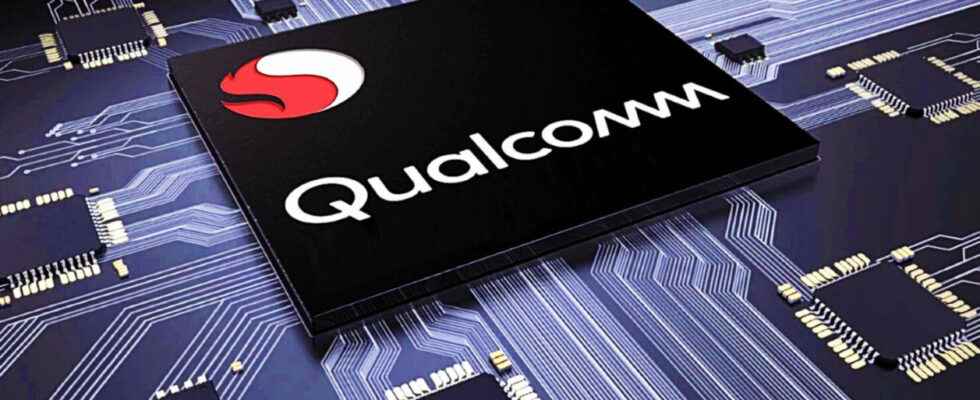Qualcomm confirmed the availability in 2023 of its high-performance ARM processor for PCs during its financial results presentation. Confirming information that we have already gleaned during the Snapdragon Summit in December 2021, Qualcomm spokespersons have guaranteed that the presentation of this new chip and architecture will be the subject of a test production for partners from the second half of 2022. An announcement will follow at the next Snapdragon Summit in December and the availability of the first machines “ end of 2023 “.
There is therefore no more speculation: by committing to its shareholders, Qualcomm validates its arrival in the arena of “high performance” chips and will be compared closely to the variations (and evolutions) of the Apple M1. But also and mostly ! – to chips from Intel and AMD.
A comparison with Apple necessary, but incomplete
It has already been almost five years since Qualcomm presented its first Snapdragon processor for PC at Computex in Taipei. But the different evolutions and even the most efficient (Snadragon 8cx) have so far not been able to tackle Core i7 and other Ryzen. This required Qualcomm to develop high-performance ARM cores and not derivatives of its mobile ARM cores. Rather than start from scratch, Qualcomm bought Nuvia, a startup founded by ARM chip design heavyweights (including the former chief architect of the Apple M1). It is these future “Phoenix” cores that will be integrated into this (these?) future chip(s).
Read also: Qualcomm pays for Nuvia, a start-up founded in 2019 by former Apple engineers (January 2021)
The words “ARM” and “PC chips” lead organically to imagine a comparison with Apple’s M1 chips. It will certainly be necessary, but not sufficient. Because while technology enthusiasts will enjoy evaluating the effectiveness of Qualcomm and Apple’s ARM architectures, the reality of the market is that Qualcomm is not a competitor to Apple. The American intends to equip PCs, under Windows or Chrome OS (even Linux). As a processor (and technological platform) supplier, it will be above all against Intel and AMD that we will have to compare future Qualcomm chips.
An ecosystem to convince

Between the “Intel is back” of the Gelsinger era with a very aggressive agenda in terms of relaunching the race for fine engraving and powerful AMD chips offering an excellent performance/consumption/price ratio, Qualcomm has a lot to do in matter of pure technology (the different elements of the chip). But also in terms of drivers and ecosystem.
Because for now, if several players – Lenovo, Microsoft, Samsung, etc. – have launched machines with Qualcomm chips, none have fully played the game to push the current models. Being able to do without active cooling, the Snapdragon 8cx Gen 3 should have been integrated into classic chassis with long-lasting batteries to really reach 24 hours of use rather than in ultrathin machines to mark the occasion. For the time being, we only have machines with limited compatibility in our hands – Windows 11 has solved a lot of problems, but not all – and without killing feature.
One of Qualcomm’s challenges will therefore be to convince the PC ecosystem to develop machines that allow it to shine in certain areas to make a difference against the competition, which is much better established.
High-level performance required to convince

Coming out at the end of 2023, the future Qualcomm / Nuvia platform will not have to be satisfied with M1 chip performance. We really have to hope that Qualcomm engineers have set the slider very high to cope with future M2, Core 13and gen and other Ryzen 7000s that will be available upon release. With the major challenge not only of the performance of its CPU part “by Nuvia” but also and above all that of its Adreno GPU. During an interview with the “fathers” of Snapdragon, Zyad Ashgar and Miguel Nunes promised us that the Adreno GPU had ” completely revised ” and “ its architecture increases very easily in power “.
Read also: Snapdragon 8cx Gen 3, we got our hands on a prototype PC with Qualcomm’s new chip
This point of performance – and compatibility! – graphics and multimedia are often forgotten by commentators, whereas they are increasingly essential. It is in particular thanks to its GPU power and the quality of its video encoders/decoders that the M1 was able to mark its difference compared to chips from Intel and AMD. It is thanks to the “RDNA2” generation GPU part of its new Ryzen 6000 that AMD intends to make a difference in the field of graphics cards integrated into mobile chips.
If Qualcomm has great success in the mobile field, it will have to do even better in the PC world. Even a giant like Intel, which is getting into dedicated graphics chips, recognizes that it has a lot of compatibility work to do when it comes to gaming.
Also see video:
Also see video:
The list of challenges for the future Qualcomm/Nuvia chip is as long as your arm. If it manages to make an impression, the PC market will benefit from additional welcome competition. If not, Qualcomm will have to content itself with pursuing its strategy of volumes of “connected” chips (4G, 5G) with low consumption in the shadows… while continuing its work.
Source : Tom’s Hardware USA
